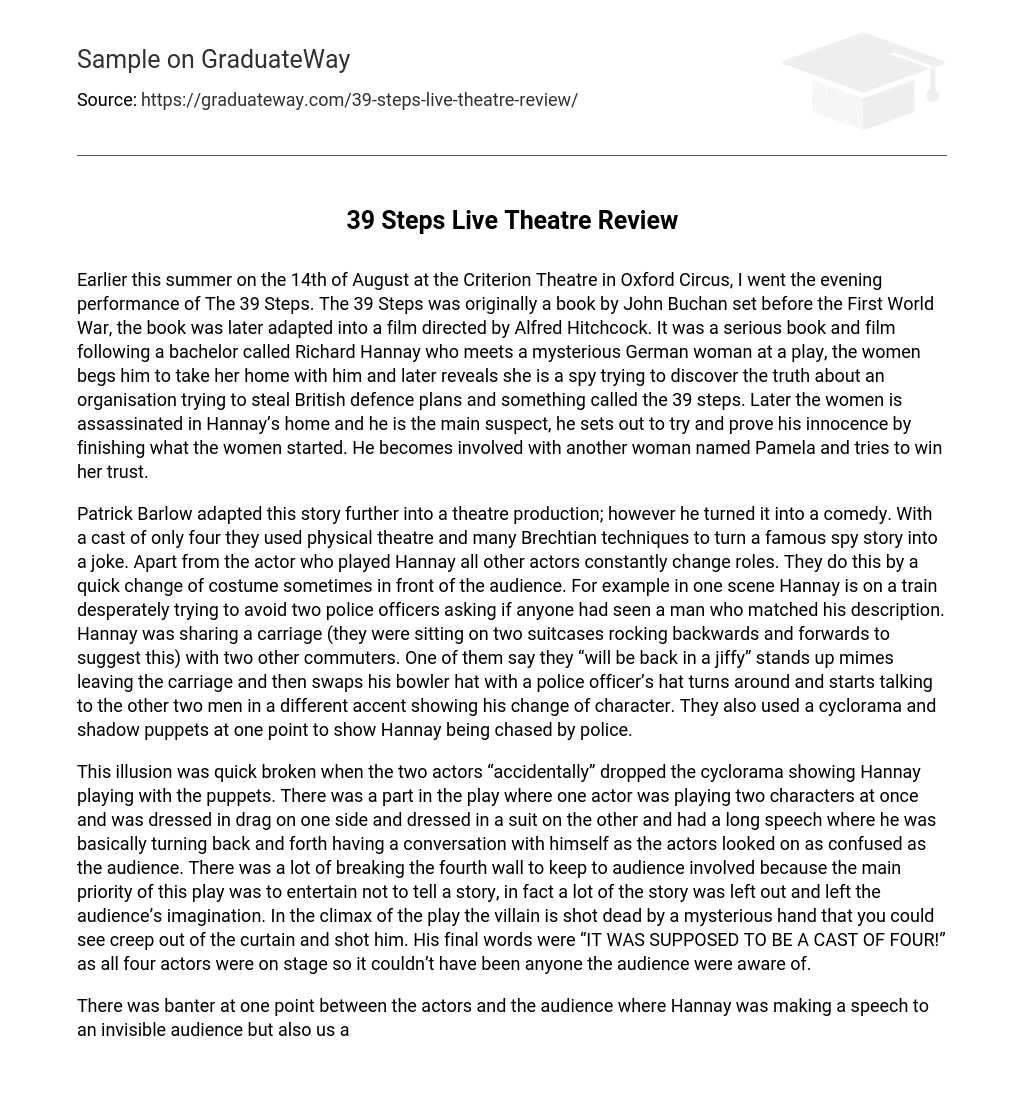Attending the evening performance of The 39 Steps at the Criterion Theatre in Oxford Circus on August 14th, I witnessed a captivating story. Originally written by John Buchan before the First World War, The 39 Steps has had a remarkable journey from book to film adaptation directed by Alfred Hitchcock.
The plot revolves around Richard Hannay, an unmarried man who attends a play and unexpectedly encounters a mysterious German woman. This enigmatic lady requests him to escort her home but soon reveals herself as a spy on a mission. Her objective is to uncover the truth behind an organization plotting to steal British defense plans and something referred to as the 39 steps.
Unfortunately, tragedy strikes when this woman is assassinated in Hannay’s residence, thrusting him into becoming the primary suspect. Driven by his determination to prove his innocence and carry on with her mission, Hannay embarks on a path that leads him through various experiences. Along this journey, he becomes entangled with another woman named Pamela and strives relentlessly to earn her trust.
Patrick Barlow adapted this story into a comedy theatre production, using physical theatre and Brechtian techniques to transform a well-known spy story into a humorous one. Despite having only four cast members, excluding the actor playing Hannay, all other actors constantly switch roles. This is achieved through rapid costume changes, sometimes performed in front of the audience. For instance, in a scene where Hannay desperately tries to avoid two police officers on a train, he shares a carriage with two other commuters. The commuter announces his departure, mimes leaving the carriage, takes a police officer’s hat and changes his accent to portray a different character. Additionally, the production incorporates a cyclorama and shadow puppets to depict Hannay being chased by the police at one point.
The magic was shattered when the cyclorama was intentionally dropped by the two actors, revealing that Hannay was actually playing with puppets. In one scene of the play, a single actor portrayed two characters simultaneously, one dressed in drag and the other in a suit. Through a lengthy speech, he effectively had a conversation with himself, confusing both the actors and the audience. The play frequently broke the fourth wall to directly engage with the audience, prioritizing entertainment over storytelling. As a result, much of the plot was left out, allowing for audience imagination to fill in any gaps. During the climax of the play, an unknown hand emerged from behind the curtain and fatally shot the villain. His final words were “It was supposed to be a cast of four!” This remark referred to all four actors being on stage at once, eliminating any potential suspects known to the audience.
During the performance, there was playful interaction between the actors and the audience. Hannay delivered a rhetorical question to both an invisible audience and us, asking if we should enjoy this peaceful period. A spectator enthusiastically shouted “YEAH!” in response, capturing Hannay’s attention. He thanked the person directly and continued the show. The actors encouraged spontaneous interaction with the audience, amidst their portrayal of various roles and settings using minimal props on a small stage. Recurring jokes, slapstick humor, and the rule of three were heavily incorporated into the play. For instance, when the German woman mentioned men following her, Hannay looked out the window as instructed. As he opened the curtains, two men appeared carrying a lamppost and positioned themselves under its light, pretending to see Hannay despite him being behind them. This hilarious gag recurred three times throughout the performance. Despite occasional confusing moments in the storyline, the play was thoroughly entertaining, and I highly recommend it to anyone.





